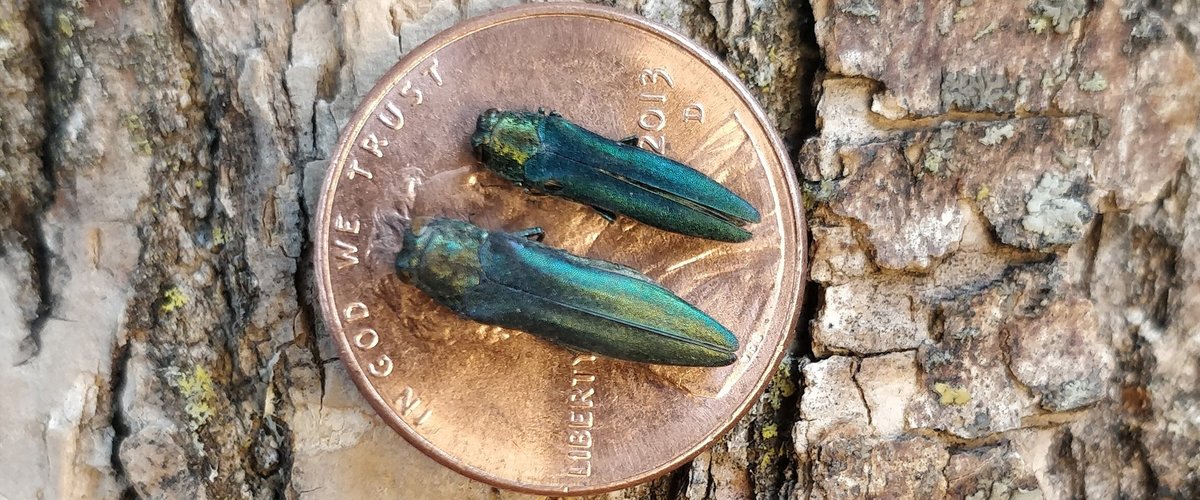
Fungi’s hidden role in the Emerald Ash Borer crisis

What makes Emerald Ash Borer beetles so deadly to Minnesota’s ash trees? New research from the CFANS Department of Plant Pathology indicates that certain fungi associated with Emerald Ash Borer beetles are playing a role in the accelerated damage to ash, but fungi are also a promising potential solution to curtailing the beetle’s rapid spread. Professor Robert Blanchette and current PhD students Sofia Simeto, Nick Rajtar, Andrew Mann, and Colin Peters are getting out into Minnesota’s cities, state parks, and forests to find fungal connections between EAB and rapid decline in ash tree populations.
Emerald Ash Borer (EAB) is an invasive beetle species that was first found in Minnesota in 2009, and has rapidly moved through the Twin Cities area into Greater Minnesota’s state parks and rural land, due both to spread of beetles and the transport of beetle-infested firewood into new areas.
“In our urban forests, ash trees can make up anywhere from 20 to 25 percent of the total tree canopy. That’s a very popular street tree. So you can imagine one in four of all your trees in a city, just dying rapidly, that’s the scale of the problem we’re dealing with,” Peters explains.
One could easily spot EAB galleries (the wood carvings beetles leave in the trees after feeding and where they dwell as larvae) under cracked bark and even the little green beetles can be seen during the summer, but there is also a variety of microscopic fungi living around the beetles that are impossible to find without proper laboratory equipment.
“Most [previous] studies of EAB center on the pest itself and the damage it does, but there was no previous work about the fungi associated with it,” Simeto explains. Different fungi found associated with EAB by Blanchette Lab students play different roles in the beetle-tree interaction, including decay fungi which accelerate the degradation of the ash tree, entomopathogenic fungi (meaning, fungi that infect and kill the beetles), and others.
Simeto’s lab work focused on inoculating ash blocks with wood-degrading fungi associated with EAB, and tracking that decay over periods of five-plus months. She says, “We could actually confirm our hypothesis that some of these fungi are having a really important role in the degradation of the wood, especially in the loss of structural integrity of the wood attacked by EAB.”

Blanchette Lab’s EAB research is deeply collaborative on a local, national, and international level. “We have a large collaboration with two universities in China, and two groups of researchers here in the U.S., us at the University of Minnesota, and Kathryn Bushley’s USDA lab in Ithaca, New York. . . we share basically the same methods that we’re applying in each of these different places to see how the microbial communities differ in different areas across North America and in China where the beetle is native,” Mann explains. He visits Minnesota forest sites several times a year to sample leaves, galleries, and other material from trees, to compare the fungi and bacteria present over time.
Peters’s field work includes the development of devices for baiting, trapping, and infecting EAB beetles with fungi as well as injecting those fungi into trees in order to find out which option could provide the best management to lower this prolific insect’s population. “All these fungi are indigenous to Minnesota, which is useful because they’ve adapted to our local climates. They’re already found in the landscape. Now we want to see, can we increase the concentration of these fungi so they can cause, essentially, epidemics in the Emerald Ash Borer populations and use these fungi as a way to reduce EAB populations across the state, slowing the spread of the beetle?”
A fungal solution like this, known as a microbial biological control, could help the already existing management tools to reduce EAB populations, like injecting trees with insecticides. Despite efficacy, insecticides can be costly and labor-intensive, making them impractical or challenging for cities with a high proportion of ash trees in their urban forests, and impossible for natural forests. The Blanchette Lab team is currently working to develop an autocontamination trap for EAB biological control. “If the traps works , this would be huge for biological control in general,” Mann explains.
“Very little work has ever been done on this. And these students are pioneers in the study of using fungi to control it and also finding out how these fungi interact with these beetles,” says Blanchette. “And I think their results are going to have a great impact on saving natural resources, not only in Minnesota, but throughout the United States.”
For several years, the Minnesota Invasive Terrestrial Plants and Pests Center (MITPPC) has provided funding for this research.





